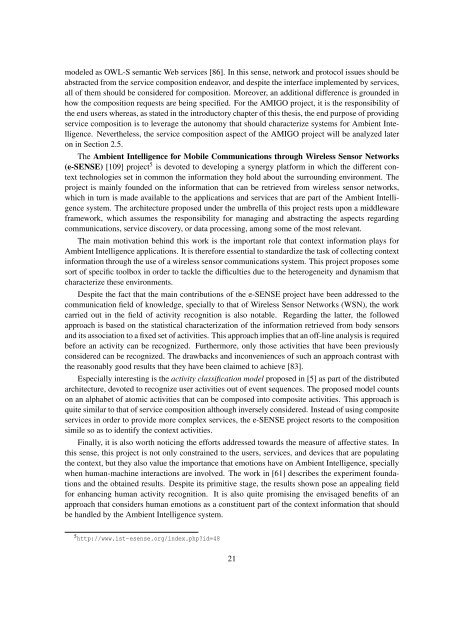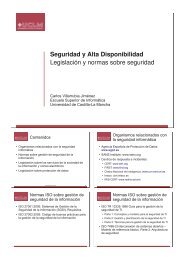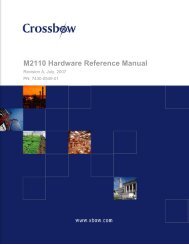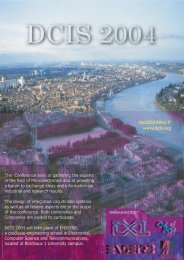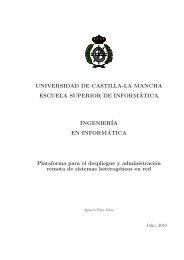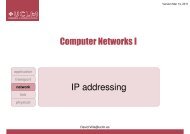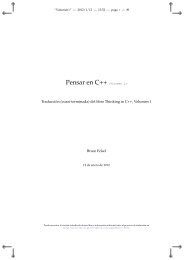MarÃa José Santofimia Romero - Grupo ARCO - Universidad de ...
MarÃa José Santofimia Romero - Grupo ARCO - Universidad de ...
MarÃa José Santofimia Romero - Grupo ARCO - Universidad de ...
You also want an ePaper? Increase the reach of your titles
YUMPU automatically turns print PDFs into web optimized ePapers that Google loves.
mo<strong>de</strong>led as OWL-S semantic Web services [86]. In this sense, network and protocol issues should beabstracted from the service composition en<strong>de</strong>avor, and <strong>de</strong>spite the interface implemented by services,all of them should be consi<strong>de</strong>red for composition. Moreover, an additional difference is groun<strong>de</strong>d inhow the composition requests are being specified. For the AMIGO project, it is the responsibility ofthe end users whereas, as stated in the introductory chapter of this thesis, the end purpose of providingservice composition is to leverage the autonomy that should characterize systems for Ambient Intelligence.Nevertheless, the service composition aspect of the AMIGO project will be analyzed lateron in Section 2.5.The Ambient Intelligence for Mobile Communications through Wireless Sensor Networks(e-SENSE) [109] project 5 is <strong>de</strong>voted to <strong>de</strong>veloping a synergy platform in which the different contexttechnologies set in common the information they hold about the surrounding environment. Theproject is mainly foun<strong>de</strong>d on the information that can be retrieved from wireless sensor networks,which in turn is ma<strong>de</strong> available to the applications and services that are part of the Ambient Intelligencesystem. The architecture proposed un<strong>de</strong>r the umbrella of this project rests upon a middlewareframework, which assumes the responsibility for managing and abstracting the aspects regardingcommunications, service discovery, or data processing, among some of the most relevant.The main motivation behind this work is the important role that context information plays forAmbient Intelligence applications. It is therefore essential to standardize the task of collecting contextinformation through the use of a wireless sensor communications system. This project proposes somesort of specific toolbox in or<strong>de</strong>r to tackle the difficulties due to the heterogeneity and dynamism thatcharacterize these environments.Despite the fact that the main contributions of the e-SENSE project have been addressed to thecommunication field of knowledge, specially to that of Wireless Sensor Networks (WSN), the workcarried out in the field of activity recognition is also notable. Regarding the latter, the followedapproach is based on the statistical characterization of the information retrieved from body sensorsand its association to a fixed set of activities. This approach implies that an off-line analysis is requiredbefore an activity can be recognized. Furthermore, only those activities that have been previouslyconsi<strong>de</strong>red can be recognized. The drawbacks and inconveniences of such an approach contrast withthe reasonably good results that they have been claimed to achieve [83].Especially interesting is the activity classification mo<strong>de</strong>l proposed in [5] as part of the distributedarchitecture, <strong>de</strong>voted to recognize user activities out of event sequences. The proposed mo<strong>de</strong>l countson an alphabet of atomic activities that can be composed into composite activities. This approach isquite similar to that of service composition although inversely consi<strong>de</strong>red. Instead of using compositeservices in or<strong>de</strong>r to provi<strong>de</strong> more complex services, the e-SENSE project resorts to the compositionsimile so as to i<strong>de</strong>ntify the context activities.Finally, it is also worth noticing the efforts addressed towards the measure of affective states. Inthis sense, this project is not only constrained to the users, services, and <strong>de</strong>vices that are populatingthe context, but they also value the importance that emotions have on Ambient Intelligence, speciallywhen human-machine interactions are involved. The work in [61] <strong>de</strong>scribes the experiment foundationsand the obtained results. Despite its primitive stage, the results shown pose an appealing fieldfor enhancing human activity recognition. It is also quite promising the envisaged benefits of anapproach that consi<strong>de</strong>rs human emotions as a constituent part of the context information that shouldbe handled by the Ambient Intelligence system.5 http://www.ist-esense.org/in<strong>de</strong>x.php?id=4821


